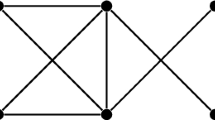Abstract
The Havel–Hakimi algorithm iteratively reduces the degree sequence of a graph to a list of zeroes. As shown by Favaron, Mahéo, and Saclé, the number of zeroes produced, known as the residue, is a lower bound on the independence number of the graph. We say that a graph has the strong Havel–Hakimi property if in each of its induced subgraphs, deleting any vertex of maximum degree reduces the degree sequence in the same way that the Havel–Hakimi algorithm does. We characterize graphs having this property (which include all threshold and matrogenic graphs) in terms of minimal forbidden induced subgraphs. We further show that for these graphs the residue equals the independence number, and a natural greedy algorithm always produces a maximum independent set.



Similar content being viewed by others
References
Amos, D., Davila, R., Pepper, R.: On the \(k\)-residue of disjoint unions of graphs with applications to \(k\)-independence. Discrete Math. 321, 24–34 (2014)
Chartrand, G., Lesniak, L., Zhang, P.: Graphs & Digraphs, 5th edn. CRC Press, Boca Raton (2011)
Fajtlowicz, S.: On conjectures of Graffiti, III. Cong. Numer. 66, 23–32 (1988)
Favaron, O., Mahéo, M., Saclé, J.-F.: On the residue of a graph. J. Graph Theory 15(1), 39–64 (1991)
Földes, S., Hammer, P.L.: On a class of matroid-producing graphs. In: Combinatorics (Proc. Fifth Hungarian Colloq., Keszthely, 1976), vol. I, pp. 331–352. Colloq. Math. Soc. János Bolyai, 18, North-Holland, Amsterdam-New York (1978)
Griggs, J., Kleitman, D.J.: Independence and the Havel–Hakimi residue, Graph theory and applications (Hakone, 1990). Discrete Math. 127(1–3), 209–212 (1994)
Hakimi, S.: On the realizability of a set of integers as degree sequences of the vertices of a graph. J. SIAM Appl. Math. 10, 496–506 (1962)
Havel, V.: A remark on the existence of finite graphs (Hungarian). C̆asopis Pĕst Mat. 80, 477–480 (1955)
Jelen, F.: \(k\)-Independence and the \(k\)-residue of a graph. J. Graph Theory 127, 209–212 (1999)
Mahadev, N.V.R., Peled, U.N.: Threshold graphs and related topics. Annals of Discrete Mathematics, 56. North-Holland Publishing Co., Amsterdam (1995)
Triesch, E.: Degree sequences of graphs and dominance order. J. Graph Theory 22(1), 89–93 (1996)
Acknowledgments
The authors wish to thank the anonymous referees for many useful comments that have improved the paper.
Author information
Authors and Affiliations
Corresponding author
Rights and permissions
About this article
Cite this article
Barrus, M.D., Molnar, G. Graphs with the Strong Havel–Hakimi Property. Graphs and Combinatorics 32, 1689–1697 (2016). https://doi.org/10.1007/s00373-015-1674-7
Received:
Revised:
Published:
Issue Date:
DOI: https://doi.org/10.1007/s00373-015-1674-7



